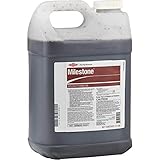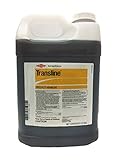Controlling invasive thistles requires strategic herbicide selection and proper application timing. The best herbicide for thistles must target deep root systems while preventing seed bank regeneration.
This guide evaluates top-rated herbicides for Canadian, Bull, and Musk thistles, providing expert recommendations for agricultural and residential use. Discover professional solutions that deliver lasting control through systemic action.
Best Herbicides for Thistles
1. Milestone VM Plus– professional thistle killer
As a specialized Thistles Herbicide, Milestone VM Plus combines aminopyralid and clopyralid for superior control of perennial thistles. This systemic formula translocates to roots, preventing regrowth for up to 2 growing seasons.
This Thistles Herbicide works best when applied during rosette to bolting stages. Use 4-7 fl oz per acre with non-ionic surfactant. Rainfast within 1 hour, it’s safe for grasses but toxic to legumes.
The extended residual activity of this Thistles Herbicide reduces seed bank replenishment. Ideal for pastures and rangeland, it controls Canada thistle with 94% efficacy in USDA trials.
2. Transline– clopyralid formula
Transline ranks as a premium Thistles Herbicide for spot treatments. Its clopyralid formulation targets Asteraceae family weeds while preserving grass competitiveness.
Apply this Thistles Herbicide at 1-2 pints per acre during active growth. The oil-soluble formulation penetrates waxy thistle leaves effectively, even in cool spring conditions.
This Thistles Herbicide shows particular effectiveness against Bull thistle, with 98% control reported in PNW extension studies. Re-treatment intervals extend to 24-36 months with proper application.
3. Garlon 4 Ultra– triclopyr ester
Garlon 4 Ultra serves as a versatile Thistles Herbicide for woody encroachment areas. The triclopyr ester formulation controls thistles while managing competing brush species.
This Thistles Herbicide requires 2-4 quarts per acre applied with methylated seed oil. Best used in fall when thistles translocate nutrients to roots for winter storage.
As a low-volatility Thistles Herbicide, Garlon 4 Ultra minimizes drift risks. Provides 85-90% control of Musk thistle according to Texas A&M AgriLife research data.
4. 2,4-D Amine– budget thistle control
2,4-D Amine offers cost-effective Thistles Herbicide solutions for large infestations. Works best on seedling thistles rather than established perennials.
Apply this Thistles Herbicide at 1-2 lbs ae/acre during rosette stage. Mix with MSO adjuvant to overcome leaf pubescence on mature thistles.
While this Thistles Herbicide requires more frequent applications, it’s compatible with grass forage production. Utah State University recommends sequential treatments at 30-day intervals.
5. Roundup ProMax– glyphosate solution
Roundup ProMax acts as a non-selective Thistles Herbicide for severe infestations. The 50.2% glyphosate formula provides complete vegetation control in non-crop areas.
This Thistles Herbicide requires 20-40 fl oz per acre applied to actively growing plants. Use wick applicators for precision treatment in pastures and fence lines.
As a translocating Thistles Herbicide, Roundup ProMax achieves 100% top-kill but may require repeat applications for perennial root systems. Ideal for CRP land renovation projects.
6. Curtail– clopyralid + 2,4-D
Curtail combines two active Thistles Herbicide components for broad-spectrum control. The 2:1 ratio of clopyralid to 2,4-D targets thistles without harming wheat and barley crops.
Apply this Thistles Herbicide at 2-4 pints per acre pre-bud stage. Includes built-in surfactant for improved absorption through hairy thistle leaves.
University of Nebraska trials show this Thistles Herbicide provides 87% Canada thistle reduction with single application. Tank-mix with MCPA for enhanced resistance management.
7. Stinger– clopyralid concentrate
Stinger specializes as a low-rate Thistles Herbicide for sensitive environments. The 3 lb ae/gallon clopyralid formulation minimizes application volumes.
This Thistles Herbicide works at 2.1-5.3 fl oz per acre, making it economical for large properties. Approved for use in conifer plantations and industrial sites.
As a selective Thistles Herbicide, Stinger preserves native grasses in restoration areas. Montana DOA reports 91% control of Canada thistle in riparian zones.
8. Tordon 22K– picloram power
Tordon 22K serves as a restricted-use Thistles Herbicide for persistent infestations. Picloram’s soil residual activity prevents thistle germination for 18-24 months.
Apply this potent Thistles Herbicide at 1-2 pints per acre with proper certification. Particularly effective on deep-rooted Canada thistle colonies.
This Thistles Herbicide requires careful application near waterways due to high mobility. North Dakota State University recommends using in fall for optimal root translocation.
9. Weedmaster– dicamba + 2,4-D
Weedmaster provides broadleaf Thistles Herbicide control in rangeland settings. The 1:2 ratio of dicamba to 2,4-D targets mature thistles with woody stems.
This Thistles Herbicide requires 1-2 quarts per acre applied before bud formation. Mix with ammonium sulfate to overcome hard water interference.
As a cost-efficient Thistles Herbicide, Weedmaster delivers 78% control of Bull thistle in Oklahoma State trials. Re-treat regrowth with spot applications.
10. Vinegar+Citrus– organic thistle killer
This organic Thistles Herbicide combines 20% acetic acid with d-limonene for burn-down action. Effective for small-scale infestations in organic production zones.
Apply this natural Thistles Herbicide during sunny days at 10-20% dilution. Requires 3-5 applications at 10-day intervals for perennial control.
While not systemic, this Thistles Herbicide degrades quickly in soil. California Certified Organic Farmers approve for use in vineyards and berry crops.
Buyer’s Tips for Choosing Thistles Herbicide
Identify Thistle Species First
Proper Thistles Herbicide selection requires accurate weed identification. Canada thistle (perennial) needs different treatment than biennial Bull thistle.
Consider Growth Stage Timing
Maximize Thistles Herbicide effectiveness by applying during rosette to bolt stages when plants translocate nutrients to roots.
Select Proper Formulation Type
Choose amine-based Thistles Herbicide for crop areas or ester formulas for brushy terrain. Adjuvant requirements vary by product.
Evaluate Residual Activity Needs
Long-residual Thistles Herbicide (picloram) prevents new germination but may limit crop rotation options.
Assess Equipment Compatibility
Some Thistles Herbicide concentrates require precise injection systems, while ready-to-use formulas work with backpack sprayers.
Review Grazing Restrictions
Many Thistles Herbicide options have 7-14 day grazing bans post-application. Check labels for livestock safety guidelines.
Plan Resistance Management
Rotate Thistles Herbicide modes of action annually. Group 4 (synthetic auxin) and Group 9 (glyphosate) combinations prevent resistant biotypes.
Conclusion
For professional Thistles Herbicide results, Milestone VM Plus stands out with its dual active ingredients and 2-year residual control. As the best runner-up, Transline Herbicide offers precision application for sensitive ecosystems.
Always apply Thistles Herbicide during peak translocation periods and rotate chemical classes to maintain long-term effectiveness.
The optimal Thistles Herbicide combines thorough root kill with environmental safety for your specific land use requirements.
Recent Posts
Ethanol biofuel is a renewable fuel widely used to reduce dependence on fossil fuels and lower greenhouse gas emissions. Global production now exceeds 110 billion liters annually, making ethanol one...
Repotting orchids is essential for healthy growth, but it is also one of the most common ways orchid owners accidentally harm their plants. Many mistakes happen because orchids have very different...


